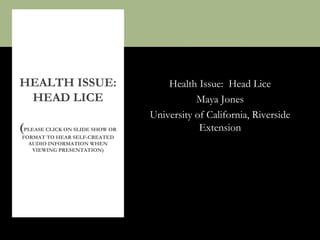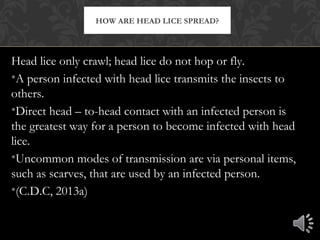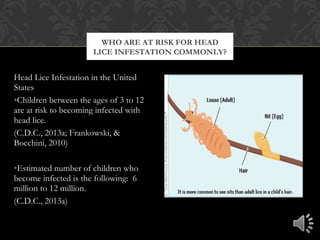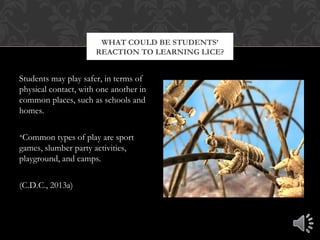Head lice are small insects that live on human heads and feed on human blood. They are spread through direct head-to-head contact with an infected person. Common signs of head lice include itching and difficulty sleeping. While head lice are not dangerous, they can be difficult to treat and costly to address. This document provides information about head lice facts, symptoms, treatment, and prevention to help educate others.


















![Bonilla, D., Durdenz, L., Eremeeva, M., & Dashe, G. (2013). The biology and taxonomy of head and body lice— implications for
louse-borne disease prevention. PLOS PATHOGENS, 9(11), 1-5. doi: 10.1371/journal.ppat.1003724
California Department of Education (CDE). (2010). Health education content standards for California public Schools, kindergarten
through grade twelve. Retrieved from http://www.cde.ca.gov/be/st/ss/documents/healthstandmar08.pdf
Centers for Disease Control. (C.D.C). (2013a). Frequently asked questions. Retrieved from
http://www.cdc.gov/parasites/lice/head/gen_info/faqs.html#symptoms
Centers for Disease Control. (C.D.C). (2013b). Head lice information for schools. Retrieved from
http://www.cdc.gov/parasites/lice/head/schools.html
Falagas, M.E., Mathaiou, D.K., Rafailidis, P.I., Panos, G., & Pappas, G. (2008). Worldwide
prevalence of head lice. Emerging Infectious Disease, 14(9), 1493 – 1494. doi: 10.3201/eid1409.080368
Frankowski, B.L., & Bocchini, J.A. (2010). Head lice. Pediatrics, 126(2), 392 – 403. doi: 10.1542/peds.2010-1308
Hansen, R.C. (2000). Guidelines for the treatment of resistant pediculosis. Contemporary Pediatrics, 4-10.
Hansen, R.C., & O’Haver, J. (2004). Economic considerations associated with pediculus humanus capitis infestation. Clinical
Pediatrics, 43(6), 523-527.
KidsHealth. (2015a). Grades Pre-K-2. Retrieved at http://classroom.kidshealth.org/index.jsp?Grade=pk&Section=personal
KidsHealth. (2015b). Grades 3-5. Retrieved at HeadLiceQuizclassroom.kidshealth.org/index.jsp?Grade=35&Section=body
NP School Nurses (Presenter). (NSN). (2014, 27 February). School nurses talk head lice [video]. Retrieved from
https://www.youtube.com/watch?v=Mlj2FrOqeHE
University of Rochester Medical Center. (U.R.M.C.). ( 2015). How much do you know about lice. Retrieved from
http://www.urmc.rochester.edu/encyclopedia/document.aspx?ContentTypeID=40&ContentID=HeadLiceQuiz
REFERENCES](https://image.slidesharecdn.com/26604076-e2fb-4802-8d77-c98be2cb69bc-150723172701-lva1-app6891/85/Jones-M-Week-2-assignment-19-320.jpg)